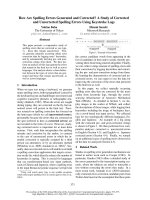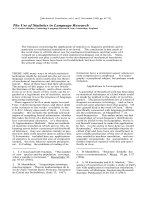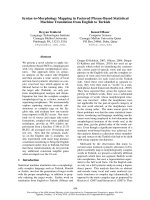Báo cáo khoa học: "How to Parse Gaps in Spoken Utterances" docx
Bạn đang xem bản rút gọn của tài liệu. Xem và tải ngay bản đầy đủ của tài liệu tại đây (296.05 KB, 3 trang )
How to Parse Gaps in Spoken Utterances
G. Goerz, C. Beckstein
Univ. Erlangen-Nuernberg, RRZE
Martensstr. I, D-8520 Erlangen, W. Germany
Phone: (09131) 85-7031, Network: Goerz~SUMEX
ABSTRACT
We describe GLP, a chart parser that
will be used as a SYNTAX module of the
Erlangen Speech Understanding System. GLP
realizes an agenda-based multiprocessing
scheme, which allows easily to apply vari-
ous parsing strategies in a transparent
way. We discuss which features have been
incorporated into the parser in order to
process speech data, in particular the abi-
lity to perform direction independent is-
land parsing, to handle gaps in the utter-
ance and its hypothesis scoring scheme.
I. GLP, A GENERAL LINGUISTIC PROCESSOR
GLP (Goerz 1981, 1982a,b) is a multi-
strategy chart-parser, which has special
features for the analysis of fragmentary
and defective input data as it is the case
with speech. GLP, a descendant of a version
of GSP by M. Kay (1975), has been implemen-
ted in InterLISP. It can be used as a
stand-alone system, to e.g. perform experi-
ments, test various parsing strategies, or
assist in the development of a linguistic
data base. While for this purpose it got a
cooperative, user-friendly interface, we
also implemented an interface to the Erlan-
gen Speech System (Niemann 1982). The
Speech System's architecture is similar to
that of HEARSAY-II, so that it employs a
variety of knowledge sources, among which
are modules for phonological, syntactic,
semantic and pragmatic analysis. Although
the structure of GLP does not limit its
ability to perform syntactic analysis only
- it is suitable for morphological or the
non-inferential part of semantic analysis
as well (see the similar system UCP, Sag-
vall-Hein (1982)) -, its role in the Speech
System is constrained to the first men-
tioned task.
II. THE ARCHITECTURE OF GLP AND ITS
EXTENSIONS FOR SPEECH ANALYSIS
The chart parsing idea was originally
conceived and further developed by Martin
Kay (1980). Its basic design extends the
Well Formed Substring Table, a device used
in many parsers to store intermediary re-
sults, which is represented as a directed
graph, and makes it into an active parsing
agent. Initially, the chart is set up as a
set of vertices which mark beginning and
end of an utterance and the boundaries bet-
ween words. The vertices are connected by
(inactive) edges which carry the lexical
information of the rasp. words. Whenever a
constituent is found during the parsing
process, a new inactive edge is added to
the chart. In contrast to that, active ed-
ges represent incomplete constituents; they
indicate an intermediate state in the
search for a phrase. Using this data struc-
ture, GLP simulates internally a multipro-
cessing scheme by means of agendas. An
agenda is a list of tasks to be carried out
over the chart. Tasks are processing steps
of different kinds, e.g. genuine analysis
~
rocesses (Syntax- and Scan-Tasks), input
output with the outside world (Listen- and
Talk-Tasks), and supervision to govern the
analysis process in the large. In order to
achieve a clear modularization, GLP is cur-
rently employing three agendas: Main for
Syntax- and Scan-Tasks, Communication for
Listen- and Talk-Tasks, and Control for
Supervisor-Tasks. Whenever edges are added
to the chart, any new tasks that can be
created as a result, are scheduled on an
agenda. The selection of tasks from an
agenda is performed by its selector, which
can, in the extreme cases, either perform a
depth-first (agenda as a stack) or a
breadth-first (agenda as a queue) search
strategy. The question of the rule invo-
cation strategy (or parsing strategy) is
independent of the choice of the search
strategy. Different parsing strategies such
as top-down or bottom-up are reflected in
different conditions for the introduction
of empty active edges. An empty edge repre-
sents the task to search a constituent; it
points to the same vertex where it is emer-
ging from, indicating the search direction.
Scheduling of tasks on an agenda is
performed by its scheduler which assigns
priorities to tasks. GLP's operation in
general is controlled by Supervisor-Tasks
on the Control agenda, while the other
tasks are executed by specific processors
(interpreters).
ill
The overall control mechanism is embed-
ded in a general interrupt system. Inter-
rupts are caused when the Main agenda - or
even a particular task - is done or when
the currently available resources are used
up, in particular time and number of tasks.
Whenever an interrupt occurs, the currently
active task is finished and control is
passed to the selector of the Control agen-
da. Then and only then input/output opera-
tions can be performed, new resources can
be assigned, and GLP's strategy can be
changed (see IV).
We do not claim any psycholinguistic
validity for this kind of system archi-
tecture, although M. Kay (1980) argues that
an agenda-based model may lead to signifi-
cant insights in cognitive psychology.
~II. SCORING
In general, there are two parts of the
problem of syntactic and semantic analysis:
Judgment or decision (whether a given
string is grammatical or not) and represen-
tation or interpretation (to decide how the
pieces of the utterance fit together and
what they mean). In a speech understanding
system, hypotheses in all levels of ab-
straction carry quality scores, which play
an important role in the overall strategy
of the system. GLP receives word hypotheses
from the Speech System's blackboard, which
have been produced by the word hypothe-
sizer, inserts appropriate word edges into
its chart, extracts their quality scores
and attaches derived priority scores to the
resp. edges as features. If gaps in the
utterance are recognized (i.e. there are no
word hypotheses in a certain time interval
with a score larger than a given threshold
value), edges are introduced which are mar-
ked with the universal category GAP and a
score feature which has the threshold as
its value.
During parsing, GLP assigns scores to
phrases. We are currently developing an
explicit focussing strategy which is simi-
lar to Woods' (1982) Shortfall Scoring
method. This method assigns priorities to
partial interpretations, the so called is-
lands, by comparing the actual score for an
island with the maximum attainable score
for the time period covered by the island
and adding to it the maximum attainable
:~cores for its environment. It can be shown
that this priority scheme guarantees the
discovery of the best matching interpreta-
tion of the utterance. In the special case
of
a GAP edge, a task is scheduled automa-
tically looking for matching word hypothe-
ses which have possibly been generated in
the meantime. With each attempt to find a
matching word hypothesis the GAP edges'
score is reduced by a certain percentage
until it falls below a second threshold. In
this case of a failure GLP constructs an
incomplete phrase hypothesis out of the
available information including the pattern
which characterizes the missing word(s). In
addition, while building phrase hypotheses,
GLP can also take into consideration pre-
ference scores (or weights) for different
branches in the grammar, but our grammar
does not employ this feature at the present
time.
IV. INCREMENTAL PARSING
Incremental parsing is a salient fea-
ture of GLP. There is no distinct setup
phase; GLP starts to work as soon as it
receives the first (some ten) word hypothe-
ses with a sufficient quality score. When-
ever an interrupt occurs, new word hypothe-
ses can be incorporated into the chart.
These hypotheses are provided by the Speech
System's word hypothesizer, either conti-
nuously or as an answer to a request by
GLP, resulting from gap processing, that
has the form of an incomplete word hypothe-
sis which is to be filled. In the latter
case active edges act as demons waiting for
new information to be imbedded in already
generated partial structures in such a way
that no duplicate analysis has to be per-
formed. Since the Speech System's overall
strategy can decide when new word hypothe-
ses are delivered, a data-driven influence
on GLP's local strategy is achieved.
The required input/output processes for
hypotheses are performed by Listen- and
Talk-Tasks, which are activated by the se-
lector attached to the Communication agen-
da. The Communication selector is triggered
by interrupt conditions, which are due to
the mentioned overall parsing strategy. The
communication channel to the outside world
can be parameterized by a general feature,
the Wait list. Whenever the name of a pro-
cessor, e.g. Listen or Talk, is put on the
Wait list, this processor is blocked until
it is removed from the Wait list. Because
blocking of any processor causes a redis-
tribution of the available resources, it
effects in conseq,~ence GLP's strategy. Di-
rect influence on the parsing strategy is
achieved by temporarily blocking the Syntax
or Scan processors. Furthermore, the stra-
tegy can be modified explicitly by attach-
ing a new selector to the Main agenda and
by setting Various global strategy parame-
ters. These include threshold values, e.g.
for gap processing, as well as limits for
resources, the most important of which is
time. This flexibility in strategy varia-
tion is important for an empirical evalua-
tion of our approach. Although we have not
yet analyzed GGP's parsing complexity in
general, some limiting factors for chart
parsing are well known by investigations on
112
the context free case by Sheil (1976): The
number of steps is o~ O (nD), the space
requirements of 0 (n 2) independent of the
parsing strategy, where n is the length of
the input sentence. The size of the grammar
does not influence complexity, but its
branching factor, which is a measure for
its degree of nondeterminism, acts as a
proportionality factor.
V. ISLAND PARSING WITH A CHART
In the following we like to point out
why we think that GLP's mechanism has seve-
ral advantages over traditional island par-
sing schemes-(e.g. Woods 1976). In order to
process defective input data, the parser
must be able to start its operation at any
point within the chart. In general, our
main parsing direction is from left to
right. With respect to the expansion of
islands, in particular from right to left,
our mechanism is simpler, because, for
example, there is no explicit representa-
tion of paths. For Syntax-Tasks, which are
proceeding in the usual way from left to
right, this information is already attached
to their corresponding active edges. Scan-
Tasks, which are seeking to the left of the
island, access information attached to the
vertex they are starting from. Phrase hypo-
theses are only generated by Syntax-Tasks;
if an island cannot be expanded to the
right, a Scan-Task which seeks an anchor
point for an active edge to the left of the
island is scheduled automatically. While in
the usual island parsing schemes the focus
of attention is not shifted left of an is-
land before appropriate hypotheses are ge-
nerated, (e.g. if there is a gap - of arbi-
trary duration - left of the island), GLP
seeks for an anchor point, attaches an ac-
tive edge to it and schedules a correspon-
ding Syntax-Task. This task will then and
only then generate a phrase hypothesis.
Furthermore, we think that our scheme is
combinatorially more efficient, because
fewer hypotheses are generated. This fact
results from a more adequate representation
of an island's left context: In usual is-
land parsing expansions to the left are
performed without regarding the left con-
text of the island as long as only predic-
tions exist and no hypotheses are availa-
ble.
The goal of the parsing strategy we are
developing now is that semantic analysis at
the constituent level can be started as
soon ~s a local constituent is syntactical-
ly recognized (bottom-up). The resulting
semantic hypotheses, produced by the
SEMANT[CS module and delivered through the
Speech System's blackboard, which contain
semantically based predictions, are then
matched against the chart. This process
will lead to the generation of new tasks,
which in turn may produce new word and
phrase hypotheses, so that present islands
can be expanded and merged.
VI. ACKNOWLEDGEMENTS
Thanks to Prof. G. Nees, who continu-
ously encouraged us in our work on GLP, and
to Prof. K.M. Colby, Roger Parkison and Dan
Christinaz of the Neuropsychiatric Insti-
tute, UCLA, where the first author learnt a
lot on robust parsing during a research
stay sponsored by the German Academic Ex-
change Service (DAAD).
VII. REFERENCES
Goerz G. (1981): GLP: A General Linguistic
Processor. Proc. IJCAI-81, Vancouver,
B.C. 1981, 429-431
Goerz G. (1982a): GLP: The Application of a
Chart Parser to Speech Understanding.
SIGART Newsletter No. 79, Jan. 1982,
52-53
Goerz G. (1982b): Applying a Chart Parser
to Speech Understanding. Proc. European
A.I. Conference, Orsay, 1982,
Kay M. (1975): Syntactic Processing and
Functional Sentence Perspective. Proc.
TINLAP-I, Cambridge, Mass., 1975, 6-9
Kay M. (1980): Algorithm Schemata and Data
Structures in Syntactic Processing. Xerox
Report CSL-80-12, Palo Alto, Calif.,
1980
Niemann, H.: The Erlangen System for Recog-
nition and Understanding of Continuous
German Speech. In: Nehmer J. (Ed.): GI -
12. Jahrestagung, Berlin: Springer IFB-
57, 1982, 330-348
Sagvall-Hein A. (1982): An Experimental
Parser. In: Horecky J. (Ed.): Proc.
COLING-82, Prague, 1982, 121-126
Sheil B. (1976): Observations on Context
Free Parsing. Star. Meth. in Linguistics
6, 1976, 71-109
Woods W. (1976): Speech Understanding Sys-
tems, Final Report, Vol. IV. Syntax and
Semantics. BBN Report 3438, Cambridge,
Mass., 1976
Woods W. (1982): Optimal Search Strategies
for Speech Understanding Control. A.I.
Journal 18, 1982, 295-326
I13









